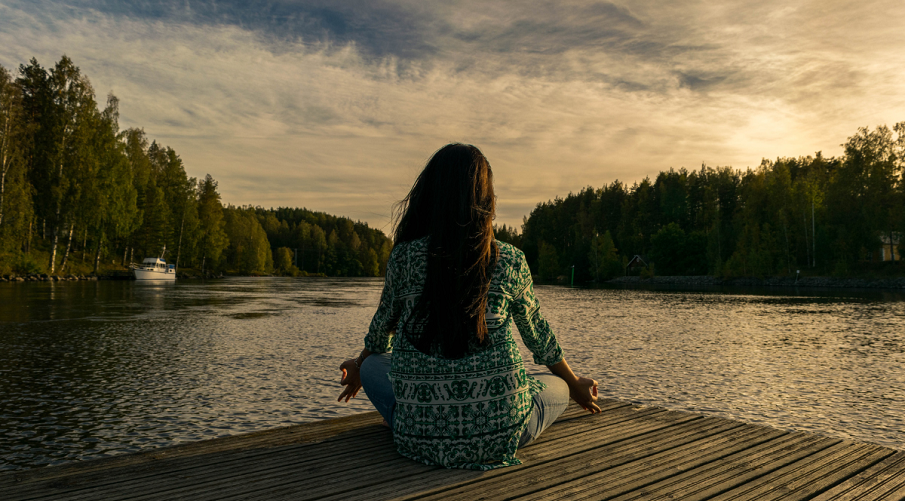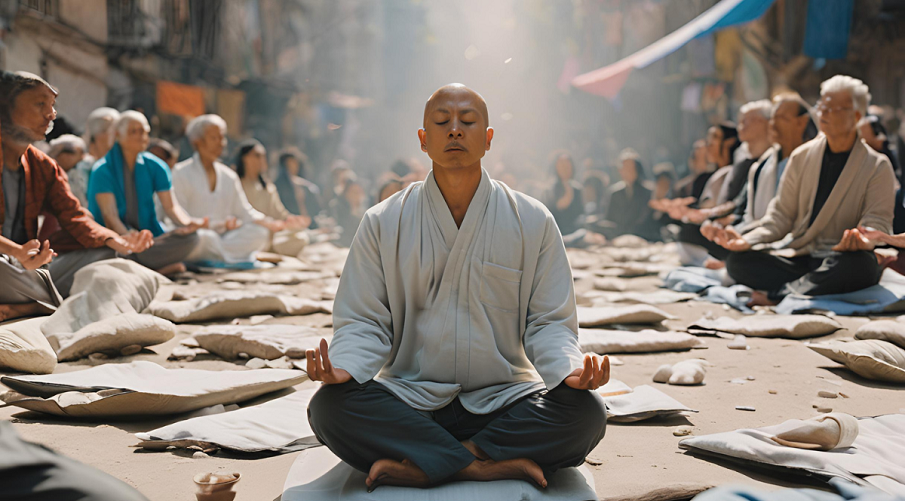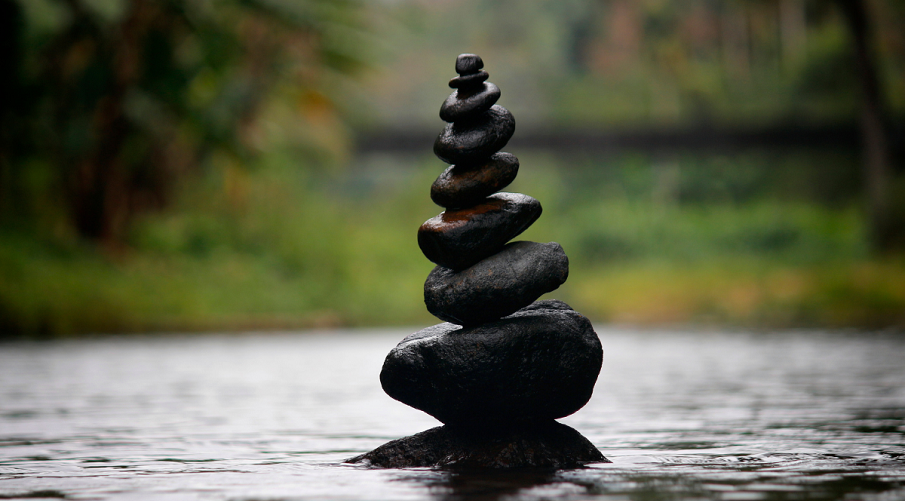When you think of the term “inner peace”, what ideas or thoughts come to your mind?
It may invoke ideas of calmness, balance, contentment, a sense of being free from external pressures of life or inner turmoil, and perhaps a state of mind, body, and spirit being in harmony!
It may also invoke the idea of a tranquil place or setting, an environment like a serene forest or beach which lets you relax and feel at ease.
It may also invoke the idea of a stable, secure, and unshakeable state where life’s ups and downs don’t upset you.
It may also bring to you the idea of a sort of mastery of your mind and becoming free of the mind’s control over you.
The notion of “inner peace” may invoke different ideas in different people.
However, I’ve found one thing in common that cuts across many people I’ve talked to.
How Do Most People See Inner Peace?
They view inner peace as something that can only be achieved once they have dealt with the demands of their daily lives—essentially, once their “worldly affairs are set.”
They think of inner peace as a lofty goal that is difficult to reach during life’s hustle and bustle.
They think that inner peace is something to achieve in the future, once they have secured financial stability, success in their career, or resolved personal issues.
In effect, they see inner peace as a reward for having “made it” in life, rather than as something that can co-exist with daily struggles.
Another common thing I’ve noticed is that people believe that inner peace is not compatible with the modern, fast-paced world, and the competitive and stressful environments they are in.
As a result, they feel that the experience of inner peace can come only if they escape from their daily grind, leading to the idea of wanting to “peace out” from their lives.
They cannot imagine integrating inner peace into their everyday experiences.
All this leads to a personal mindset which is consistent with the broader societal belief that inner peace is something elusive, and attainable only in a life free of stress, conflict, and responsibilities.
This leads to the assumption that inner peace is incompatible with modern life, impossible while participating in the rat race.
But is this true? Is inner peace a lofty and unattainable goal? Is inner peace not compatible with modern life?
We need to look closely at these assumptions about inner peace.
What Is Inner Peace?

The very wording, “inner peace,” implies that peace is something inside you.
If it is inside you, it must be a part of you.
If it is a part of you, where is it to be found?
Inner peace cannot be in the body, because, if you pay attention to the language you use, you refer to “peace of mind,” not “peace of body,” correct?
So, “inner peace” must be in the mind.
But is that true?
Mind is merely one thought after another… isn’t this how you experience the mind at work?
The anatomy and physiology of the brain is not important in this inquiry.
How do you experience your mind?
One thought after another.. often so fast paced, tangled, and running in streams of thoughts, but always one thought after another.
Thoughts may be fed by beliefs, experiences, desires, expectations, judgments, and myriad other factors, but mind’s expression is merely one thought after another.
Do thoughts and even trains of thoughts bring you the experience of “inner peace”?
No!
It is the monkey-mind occupied with 60,000 or more thoughts a day that obscures the experience of “inner peace.”
So, inner peace is not in the running mind.
When the mind comes to a halt, it brings forth the experience of peace.
You don’t have to believe me.
Look back to an experience where you’ve noticed this yourself – perhaps you were out in nature and experienced a stunning landscape that took your breath away and quieted your mind – there, the experience of peace naturally arises.
The same happens in listening to a piece of music, or seeing a stunning piece of art, and so forth.
It is when the monkey-mind stops that peace is felt.
So, peace must exist in you before your rising and running mind.
But what exists before your mind?
Inner peace, as we are discovering in this inquiry, is not in the body, and not in the mind.
Where is inner peace inside you?
Peace arises as the natural experience of calmness from within you, when moving mind comes to a stop.
This inner peace exists within you before your experience of body and mind.
This inner peace is also present always, because no matter where you are, no matter the time or setting, inner peace can arise into your experience as calmness.
i.e., Inner peace is ever-present within you, obscured by the monkey-mind.
The great awakened master, Ramana Maharshi has pointed to this.
“Peace is the inner nature of humankind.” — Ramana Maharshi
Inner peace is your own real nature, ever-present, unchanging.
Your experience of inner peace as calmness, tranquility, serenity etc. may come and go – and that has everything to do with the states of your moving mind.
But inner peace itself is unchanging, ever-present.
Unchanging inner peace is your original nature.
In other words, what your heart opens you to, and what your spirit truly is, is unchanging inner peace.
The Nature of Inner Peace

Inner peace is your real nature.
Your experience of inner peace comes and goes, but inner peace itself is ever-present and unchanging.
All your experiences come and go, they are inherently transient.
However, inner peace itself is ever-present and unchanging.
This is not theology or philosophy.
This lends itself to direct verification through your experience.
When you experience inner peace, the most easily recognizable aspect of it is the experience of calmness.
Where you may have felt agitated or perturbed by your thoughts and feelings before, calmness is a welcome experience.
When you feel calm, you can see things more clearly, you can experience things more directly, you can begin to think in clear terms.
Where calmness is, clarity is.
When you are calm, your mind is not moving into the past or the future.
Rather, you are present.
Lao Tzu’s teaching affirms this.
“If you are depressed you are living in the past if you are anxious you are living in the future, if you are at peace, you are living in the present.” — Lao Tzu
When you are present, you are more able to respond to life than react to it, and this is a wise way to live.
Where calmness is, wisdom is.
When you are feeling calm, you are not drowning in fears, anxieties, and self-doubt.
Rather, when you are calm, you’re naturally courageous.
Where calmness is, courage is.
When you are feeling calm, your energies are not leeched off by negative thoughts and draining feelings.
Rather when you are calm, you’re naturally strong.
Where calmness is, strength is.
When you are feeling calm, you are not judging others or the experiences around you.
Rather, when you are calm, you’re naturally empathetic and kind.
Where calmness is, compassion is.
When you are feeling calm, you are not confined within set ways of thinking, you are not confined to a box.
Rather when you are calm, you’re naturally open to ideas out of the box.
Where calmness is, creativity is.
Such is the nature of calmness, the experience of unchanging inner peace.
The Benefits of Inner Peace
When you are calm, you have clarity, wisdom, courage, strength, compassion, and creativity.
These are the ingredients you need to make wise decisions and take powerful actions, which in turn, are the very things you should do to orient yourself towards success and fulfillment.
Calmness is the experience of inner peace.
Not only does calmness beat stress, eliminate fears and anxieties, dissolve judgments and anger, calmness also helps you tap into everything you need to succeed and experience fulfillment.
This is what Wayne Dyer, beloved spiritual teacher also said:
“Being relaxed, at peace with yourself, confident, emotionally neutral, loose, and free-floating — these are the keys to successful performance in almost everything.” — Wayne Dyer
Something as simple as calmness can unleash your inner power into your everyday life.
Cultivate Inner Peace and Unleash Your Inner Power

The renowned Buddhist monk and teacher, Thich Nhat Hanh said:
“Every breath we take, every step we make, can be filled with peace, joy and serenity.” — Thich Nhat Hanh
Inner peace need not be a distant, lofty goal.
You can cultivate inner peace and experience it every breath you take and every step you make.
Why should you do this? Why should you cultivate inner peace?
Martin Luther King Jr. said:
“One day we must come to see that peace is not merely a distant goal we seek, but that it is a means by which we arrive at that goal.” — Martin Luther King Jr.
Pause and consider this.
What Martin Luther King Jr. says about peace in the world is true about inner peace too.
Inner peace is not a distant goal.
Inner peace is the means to arrive at that goal.
Inner peace is your inner power.
When you cultivate inner peace, you unleash your inner power into your life.
What can the consistent experience of calmness do for you?
What can natural, steady access to clarity, wisdom, courage, strength, creativity, and compassion do for you?
Inquire within and find out for yourself.
The Paradigm Shift of Inner Peace
Inner peace is how you remain calm during life’s storms, while working toward your goals with clarity and wisdom, courage and strength, creativity and compassion.
By unleashing your inner power, you orient yourself better toward success and fulfillment in your life.
Can you see how mistaken the idea is, that inner peace is a lofty, impractical, and unachievable goal in modern life?
Can you see how inner peace is your inner power?
Can you see how vital it is to cultivate inner peace so you can connect to your inner power and unleash it in your daily life?
Knowing what you do now about inner peace, does it make any sense to ignore your inner power as you plow through life’s hardships and ups and downs?
This is all well and good in theory.
But how to make this practical?
How to make this work within the confines of the stressful, busy, daily life? How to make it fit in the context of the modern rat race?
For this, you must know how to cultivate inner peace, and that is the subject of our next article in this series.
About the Author
Sundar Kadayam is an author, spiritual teacher, mentor, and healer. Midway through his 34 year career as a technologist and entrepreneur, life circumstances pushed him into an unlikely journey toward healing and awakening. His offerings provide guidance on self care and healing, self transformation, and self realization.
Sundar’s Website: Being YOU with Sundar Kadayam – Resources for self-care and healing, continuous self-transformation, and Self-Realization
Sundar’s Bio: About Sundar Kadayam
Sundar’s Writings: Articles and Pointers to Being YOU – with Sundar Kadayam
Life Coach Code Interview: Find Life Coach | Meet Sundar Kadayam: How to Go from Weakness to True Power and Limitless Potential? (lifecoachcode.com)
Related Articles from Sundar:
- What is Peace? (sundar.com)
- Peace is not an Achievement (sundar.com)
- Grace and Peace (sundar.com)
- The Cultivation of Peace (sundar.com)






